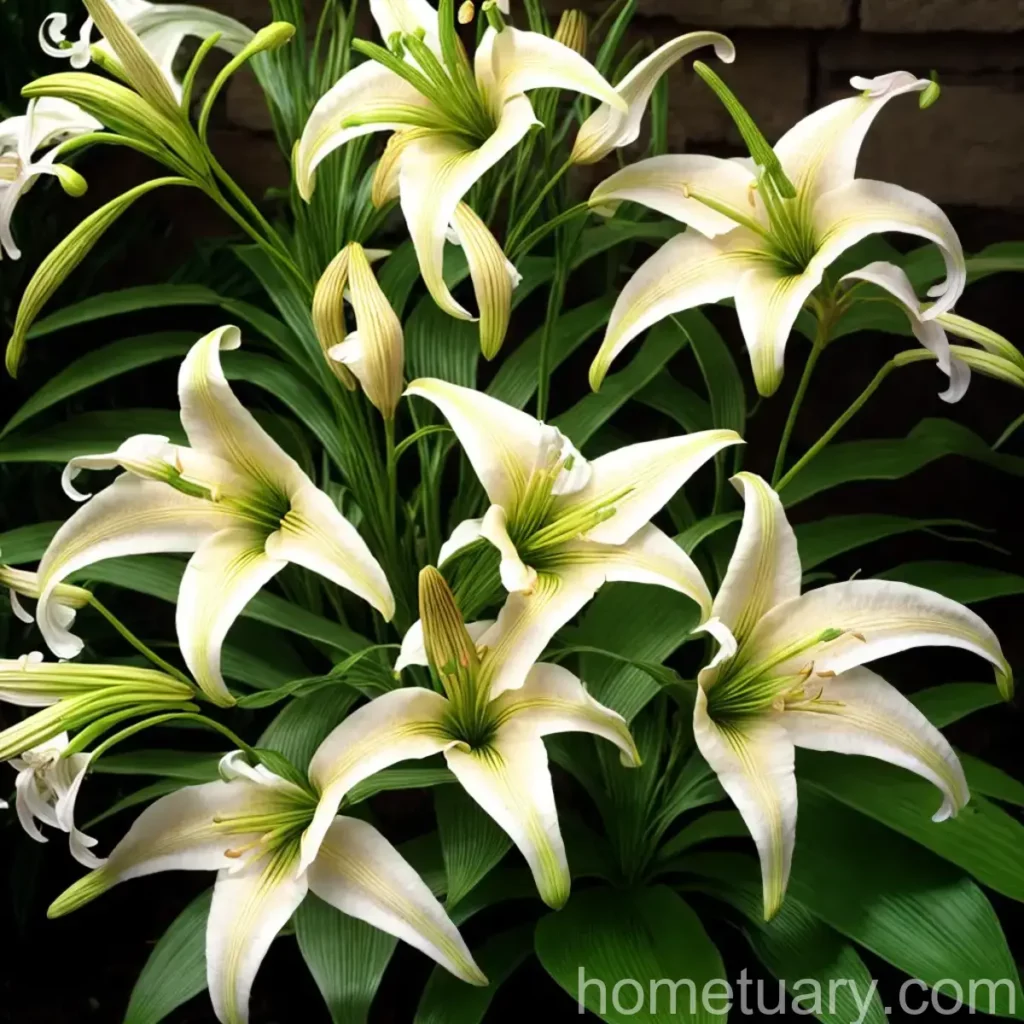Trumpet Lily (Lilium African Queen Group): A Complete Guide to Cultivation and Care
As a plant scientist with a passion for ornamental plants, I have always been fascinated by the beauty and diversity of lilies. Among the various types of lilies, the trumpet lily, scientifically known as Lilium (African Queen Group), stands out for its elegant trumpet-shaped flowers and delightful fragrance. In this comprehensive guide, we will delve into the details of trumpet lily cultivation, maintenance, and care. Whether you are a novice gardener or an experienced horticulturist, this guide will equip you with essential knowledge to successfully grow and nurture the exquisite trumpet lilies in your garden or containers.
This guide is structured to provide in-depth insights into various aspects of trumpet lily care, including its cultural requirements, uses, propagation, common diseases, pests, and fun facts. By the end of this guide, you will have a thorough understanding of how to cultivate and care for trumpet lilies, ensuring that they thrive and enchant with their stunning blooms.
Overview of Trumpet Lily (Lilium African Queen Group)
Before we delve into the specifics of cultivating and caring for trumpet lilies, let’s start by getting to know this captivating flowering plant.
What is Trumpet Lily (Lilium African Queen Group)?
The trumpet lily, belonging to the Lilium (African Queen Group), is a stunning perennial bulbous plant known for its trumpet-shaped flowers and elegant appearance. This group of lilies is known for its robust growth habit and striking blooms, making it a popular choice among gardeners and flower enthusiasts.
Key Takeaways
Here are some key takeaways to keep in mind as we delve deeper into the cultivation and care of trumpet lilies:
- Common Name: Trumpet Lily (Lilium African Queen Group)
- Scientific Name: Lilium (African Queen Group)
- Cultural Group: Trumpet Lily
- Plant Type: Perennial bulbous plant
In the following sections, we will explore the essential aspects of trumpet lily cultivation and care, including cultural requirements, uses, propagation, common diseases, pests, and more.
Cultivation and Care of Trumpet Lily (Lilium African Queen Group)
Cultivating and caring for trumpet lilies requires attention to various factors such as water, sunlight, fertilizer, soil, pruning, and propagation. Let’s explore each of these aspects in detail to provide a comprehensive understanding of the requirements for successfully growing trumpet lilies.
Culture
Cultural practices play a crucial role in the successful cultivation of trumpet lilies. Here are the key cultural aspects to consider when growing trumpet lilies:
- Uses:
-
Trumpet lilies are widely utilized in gardens and landscapes for their striking visual appeal and captivating fragrance. Additionally, they are popular as cut flowers, often used in floral arrangements and bouquets due to their long-lasting blooms and enticing scent.
-
Water:
-
Adequate moisture is essential for the healthy growth of trumpet lilies. Ensure that the soil is consistently moist but well-drained. Avoid waterlogging, as excessive moisture can lead to bulb rot and other fungal diseases. During the growing season, regular watering is crucial, especially during dry periods.
-
Sunlight:
-
Trumpet lilies thrive in locations with full to partial sun exposure. Ensure that they receive at least 6-8 hours of direct sunlight daily for optimal growth and abundant flowering.
-
Fertilizer:
-
Fertilize trumpet lilies with a balanced, slow-release fertilizer in early spring as new growth begins. Avoid high-nitrogen fertilizers, as they can promote lush foliage at the expense of flowering. Additionally, a light application of a balanced fertilizer after flowering can support the development of healthy bulbs for the following year.
-
Soil:
-
Well-draining, fertile soil is essential for trumpet lilies. They prefer slightly acidic to neutral soil with good organic content. Amending the soil with organic matter such as compost or well-rotted manure before planting can improve soil structure and fertility, providing an ideal growing medium for trumpet lilies.
-
Pruning:
-
After the trumpet lily blooms have faded, deadhead the flowers to prevent seed formation and redirect the plant’s energy towards bulb development. Avoid cutting back the foliage until it has turned yellow and started to die back naturally. This allows the plant to replenish energy stores in the bulb for the next growing season.
-
Propagation:
-
Trumpet lilies can be propagated through division of bulbs. This is typically done in late summer or early autumn when the plants are dormant. Carefully dig up the bulbs, separate the offsets, and replant them in prepared soil to establish new plants.
-
Container Popularity:
- Trumpet lilies are also well-suited for container cultivation, allowing gardeners to enjoy their beauty on patios, balconies, and other outdoor spaces. When growing in containers, ensure that the pots have sufficient drainage holes to prevent waterlogging and use a well-draining potting mix tailored for bulbs or perennials.
Common Diseases and Pests
Despite their enchanting beauty, trumpet lilies may be susceptible to certain diseases and pests. Understanding these potential challenges is crucial for maintaining the health and vigor of the plants.
Common Diseases
- Disease Diagnosis:
- Common diseases that can affect trumpet lilies include botrytis blight, lily mosaic virus, and botrytis leaf blight. Symptoms of these diseases may include discolored or distorted foliage, stunted growth, and reduced flowering.
Common Pests
- Common Pests:
- Trumpet lilies can be vulnerable to pests such as aphids, lily beetles, and slugs. These pests may feed on the foliage, flowers, or bulbs, leading to visible damage and compromising the overall health of the plants.
Botanist’s Tips for Growing Trumpet Lilies
To ensure the successful cultivation of trumpet lilies, consider the following expert tips and recommendations:
- Select a planting site with well-draining soil and ample sunlight to promote healthy growth and abundant flowering.
- Water trumpet lilies consistently, keeping the soil evenly moist but not waterlogged, especially during the active growing season.
- Apply a balanced, slow-release fertilizer in early spring to support strong growth and prolific flowering.
- Monitor the plants regularly for signs of diseases and pests, taking prompt action to address any issues and prevent their spread.
Fun Facts about Trumpet Lilies
Let’s explore some intriguing and delightful facts about trumpet lilies:
- The Lilium (African Queen Group) encompasses a captivating range of lily varieties, each boasting unique characteristics and captivating beauty.
- Trumpet lilies are known for their enticing fragrance, often described as sweet and intoxicating, making them a favorite choice for floral arrangements and bouquets.
- The trumpet-shaped flowers of these lilies symbolize purity, virtue, and renewal, endowing them with cultural and symbolic significance across various traditions and customs.
Links to External Resources
For additional information on trumpet lily cultivation and care, explore the following external resources:
- Royal Horticultural Society – Growing Lilies
- American Society for the Prevention of Cruelty to Animals – Toxic and Non-Toxic Plants: Lily
- University of Illinois Extension – Lily Leaf Beetle
- The Spruce – How to Grow and Care for Trumpet Lilies
In conclusion, the exquisite trumpet lily, belonging to the Lilium (African Queen Group), offers a delightful addition to gardens, landscapes, and floral arrangements. By understanding and implementing the cultural requirements, maintenance practices, and care tips outlined in this guide, you can ensure the successful cultivation and flourishing of these magnificent flowering plants. Whether you are captivated by their enchanting blooms or enticed by their intoxicating fragrance, trumpet lilies are sure to enrich your outdoor spaces with their timeless beauty and charm.
As you embark on your trumpet lily gardening journey, may your efforts be rewarded with bountiful blooms and the joy of nurturing these floral treasures. Happy gardening!
References
- Royal Horticultural Society. “Growing Lilies.” https://www.rhs.org.uk/advice/profile?pid=133
- American Society for the Prevention of Cruelty to Animals. “Toxic and Non-Toxic Plants: Lily.” https://www.aspca.org/pet-care/animal-poison-control/toxic-and-non-toxic-plants/lily
- University of Illinois Extension. “Lily Leaf Beetle.” https://extension.illinois.edu/blogs/good-growing/2020-05-21-lily-leaf-beetle
- The Spruce. “How to Grow and Care for Trumpet Lilies.” https://www.thespruce.com/how-to-grow-and-care-for-trumpet-lilies-4687200















